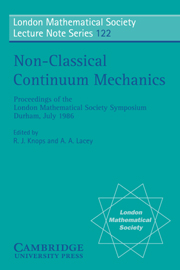 Non-Classical Continuum Mechanics
Non-Classical Continuum Mechanics Book contents
- Frontmatter
- FOREWORD
- Contents
- LIST OF PARTICIPANTS
- PART I PRINCIPAL LECTURES
- PART II SINGLE INVITED LECTURES
- Some Mathematical Problems Arising From the Oil Service Industry
- Randomly Diluted Inhomogeneous Elastic Networks near the Percolation Threshold
- Adaptive Anisotropy: An Example in Living Bone
- Stability of Elastic Crystals
- Optimal Bounds for Conduction in Two-Dimensional, Two-Phase, Anisotropic Media
- Rapid Flows of Granular Materials
- The Constrained Least Gradient Problem
- The Fusion of Physical and Continuum-Mechanical Concepts in the Formulation of Constitutive Relations for Elastic-Plastic Materials
- Singularities in Elliptic Non–Smooth Problems. Applications to Elasticity
- Solitons in Elastic Solids Exhibiting Phase Transitions
- On the Dynamics of Structural Phase Transitions in Shape Memory Alloy
- On the Homogenization of Some Free Boundary Problems
- The Point Interaction Approximation, Viscous Flow Through Porous Media, and Related Topics
Adaptive Anisotropy: An Example in Living Bone
Published online by Cambridge University Press: 11 May 2010
- Frontmatter
- FOREWORD
- Contents
- LIST OF PARTICIPANTS
- PART I PRINCIPAL LECTURES
- PART II SINGLE INVITED LECTURES
- Some Mathematical Problems Arising From the Oil Service Industry
- Randomly Diluted Inhomogeneous Elastic Networks near the Percolation Threshold
- Adaptive Anisotropy: An Example in Living Bone
- Stability of Elastic Crystals
- Optimal Bounds for Conduction in Two-Dimensional, Two-Phase, Anisotropic Media
- Rapid Flows of Granular Materials
- The Constrained Least Gradient Problem
- The Fusion of Physical and Continuum-Mechanical Concepts in the Formulation of Constitutive Relations for Elastic-Plastic Materials
- Singularities in Elliptic Non–Smooth Problems. Applications to Elasticity
- Solitons in Elastic Solids Exhibiting Phase Transitions
- On the Dynamics of Structural Phase Transitions in Shape Memory Alloy
- On the Homogenization of Some Free Boundary Problems
- The Point Interaction Approximation, Viscous Flow Through Porous Media, and Related Topics
Summary
Abstract
Many natural materials adjust to their environmentally applied loads by changing their microstructure. These microstructural changes induce changes in the mechanical anisotropy of the material. Thus, the anisotropy of the material adapts to the applied loads. Materials that adapt their anisotropy by mechanical means include soft living tissue, rocks and all granular materials. Materials that adapt their anisotropy by chemical means include living bones and trees and saturated sandstones and limestones. In this paper an example of adaptive anisotropy in living bone is presented.
Introduction
Many natural materials possess mechanisms by which they adjust the degree of their anisotropy in order to carry, more efficiently, the load to which they are being subjected. By the degree of anisotropy we mean the relative stiffness or compliance of the material in different directions. For example, some fibrous composites have a ratio of Young's modulus in their fiber direction to Young's modulus in their transverse direction of 200. These materials are said to be strongly anisotropic. On the other hand bone can be described as mildly anisotropic because the ratio of Young's moduli in different directions generally exceeds two. However, bone has a mechanism by which it changes the degree of its anisotropy to adjust to its environmental load and manmade fibrous composites do not generally possess these adaptive mechanisms. As an example of the effect of this adaptive mechanism in bone one can note the fact that the ratio of Young's moduli near the mid-shaft of the human femur is about two, but it decreases to near one (almost isotropic) near the joints.
- Type
- Chapter
- Information
- Non-Classical Continuum MechanicsProceedings of the London Mathematical Society Symposium, Durham, July 1986, pp. 174 - 186Publisher: Cambridge University PressPrint publication year: 1987
